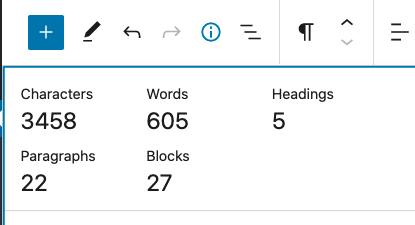Count words, not pages

I often ask writers I’m coaching how many words will be in the piece they are planning to write. They frequently don’t know. They say things like “It will be about three pages long.”
You should get used to thinking in word counts rather than page counts. Why? Because word counts are the best measurement of how much effort the reader must expend to consume and comprehend what you have written, a better way to measure that than page counts.
Here’s are some reasons why word counts are a better way to think about writing.
Page counts vary based on factors that have little to do with writing
Your page count will be different based on things like font size, spacing between lines and paragraphs, margins, and page size. Furthermore, your reader may be consuming this text on a printed page, a computer screen, a tablet, or a mobile phone. So “pages” isn’t an accurate or consistent measurement of how much content you need to create — or how the reader will consume it.
Page counts also vary based on graphics
Consider two documents.
The first one is five pages long and includes three large conceptual diagrams and 100 words of text.
The second is one-and-a-half pages long and includes 500 words of text in long paragraphs.
Which one is more challenging to consume?
Unless the diagrams are terrible, the longer document with the diagrams will require less time and effort to comprehend. So if you’re a writer, you don’t want to think of five pages as being “more” than a page and a half.
Note that text-heavy tables have words included in the word count, while graphics-heavy diagrams do not. This reflects the work the reader must expend to comprehend them. (If you have a text-heavy graphic, you should probably reconsider whether it’s the best way to explain things.)
Word counts determine structural decisions
Do you need an executive summary? If you have 500 words or more, it would help. But if you have fewer words, it’s redundant.
Should you divide your writing into sections with subheads? Should you have more than one level of heads? These decisions all depend on the word count, not the page count.
The 100-word article with all the diagrams probably doesn’t need subheads, while the 500-word piece that’s all text probably does.
So when you’re thinking about structure, think about word counts, not page counts.
Writing professionals speak in word counts
If you’re writing an article, you should ask the client or the publication “how many words?” While you shouldn’t charge by the word, you should deliver the piece to fit the audience and the publication. The same is true if you’re writing web copy or a blog post or a memo — you should write to fit what the reader and the format requires.
Word counts are a rough proxy for the level of effort to create an article, and the level of effort to consume it.
That’s why writers and editors speak in terms of word counts, not page counts — it’s the metric they prefer.
This applies to books, as well. A 30,000-word book is a very different creature from a 60,000-word book or a 100,000-word book. Your publisher wants to know which you are promising, and that number should be in your proposal and your contract.
Word counts are easy to track
Microsoft Word includes a word count at the bottom of each window as well as a “Tools/Word Count” menu item.
Google Docs also has a “Tools/Word Count” menu item and an option to display the word count when writing.
WordPress also includes easy access to a word counter.
So watch your word count as you write, and shape your content to fit the count you’re targeting.
If you observe the word count, you can ensure that you spend your word budget on the topics that matter most.
Stop thinking in pages. Start thinking in word counts. Once you do that, you’ll have taken another step towards becoming a part of the professional writing community.
No question, and all good points! One domain (which doesn’t involve professional writers, per se, although it may involve professional editors) is proposal writing for government entities. There the Request for Proposal often has a hard page count limit. And at least in the Federal government, they’ll accept a longer proposal, but will literally stop reading at the page count max. and score the proposal on only what fit within the pages up to that point.
They will usually, but not always, specify a font size and typeface to be used, which makes it more apples to apples with the exception of figures and tables (and, of course, when they don’t, delivering a brilliantly writen but wordy proposal in 6 pt. type won’t help you win the contract).. They also will sometimes specify the size of the paper, as they may have been burned by that loophole before. I once helped the government review a proposal where literally every other page was a fold out, which was within the rules. They also won that award, but that had nothing to do with their use of foldouts.
When on the other side, writing proposals, we had a fantastic editor where I worked who, in addition to adding value with her general editing skills for clarity, calling out unsubstantiated claims, etc., was fantastic both at editing out every extraneous word and organizing the layout to minimize page count.